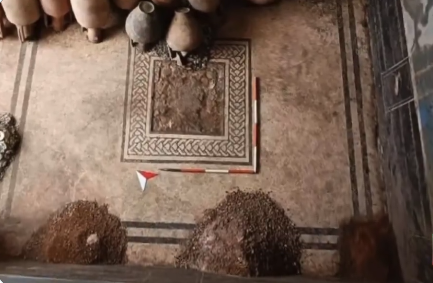The Roman Empire continues to amaze us all with each new finding
Archaeologists excavating the ancient city of Pompeii, which was buried under volcanic ash by Mount Vesuvius in 79 AD, have recently unearthed a remarkable find—a room with walls painted a vivid, unusual blue. This striking blue, a color rarely found among the ruins, adorned the walls of what appears to have been a significant space, potentially used for pagan rituals and the storage of sacred items.
Pompeii archaeologists uncover incredibly rare blue room#Pompeii pic.twitter.com/dP4BWzKpxn
— B.C. Begley (@BC_News1) June 5, 2024
The brilliantly colored room featured frescoes of female figures, symbolizing the four seasons, and included scenes of agricultural and pastoral life. Such vibrant hues and themes suggest the room held substantial cultural or religious importance. This area, now known as Room 32, was part of a larger excavation project that has revealed over 13,000 rooms across 1,070 residences in Pompeii, a bustling city before the catastrophic eruption.
Pompeii, located about 14 miles southeast of Naples, had a population of approximately 15,000 at the time of the eruption, which is believed to have claimed the lives of 16,000 people, making it one of history’s deadliest volcanic events. Despite first being discovered in 1748, the ruins continue to offer new insights into the daily lives and practices of its ancient residents.
"Pompeii archaeologists uncover incredibly rare blue room with stunning frescoes of female figures"https://t.co/1hcc7N4rRg
— Bufo Calvin (@bufocalvin) June 4, 2024
The recent discovery was made in a second-floor housing unit, where archaeologists found a hidden tunnel leading to the extraordinary blue room. Accessed via a vestibule that opened into a garden lush with fruit trees and vines, this room was characterized by its intimate and private nature, likely serving as a space for private religious ceremonies.
The frescoes depict four women, each holding an object and crowned with flowers, some dressed in flowing gowns while others are depicted without clothing. The walls also boasted intricate gold details, including hand-painted pavilions, preserved through millennia. Inside the room, researchers found 15 jugs positioned against the wall, oil lamps, and three ornamental boxes embedded in the walls, which likely once held devotional statues.
Blue is the new black (room) in #Pompeii.https://t.co/NP2424SFvk@pompeii_sites pic.twitter.com/fx9lgGeR3Z
— Dr Sophie Hay (@pompei79) June 3, 2024
Further discoveries included piles of oyster shells, indicating ongoing renovations involving the use of these shells mixed with plaster and mortar just before the volcanic disaster. Although the room had been accessed in the 17th and 18th centuries, likely by looters who removed the statues, its historical significance remains undiminished.
The sole contemporary written account of the Vesuvius eruption comes from Pliny the Younger, a poet who observed the disaster from afar. His letters, found in the 16th century, describe a terrifying column of smoke rising like an umbrella pine from the volcano, turning day into night across the region. Pliny’s writings detail the eruption’s duration of approximately 24 hours, with the first deadly pyroclastic surges beginning at midnight, unleashing a rapid avalanche of ash, rock, and toxic gases at speeds of 124 miles per hour. This overwhelming force instantaneously buried residents and obliterated the vestiges of daily life, including hundreds of refugees in nearby Herculaneum who were caught while seeking shelter.
Major Points
- Archaeologists in Pompeii discovered a room with rare bright blue walls, suggesting its use for significant cultural or religious activities.
- The room, part of a larger excavation project, featured frescoes depicting the four seasons and scenes of agriculture and shepherding.
- Findings included frescoes, 15 jugs, oil lamps, and ornamental boxes likely holding sacred statues, indicating the room’s religious significance.
- Historical records by Pliny the Younger provide the only contemporary account of the catastrophic eruption of Mount Vesuvius in 79 AD.
- The excavation revealed ongoing renovations at the time of the eruption, with materials like oyster shells found mixed with plaster and mortar.
Kirk Volo – Reprinted with permission of Whatfinger News



